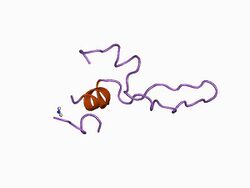Biology:Cholecystokinin A receptor
 Generic protein structure example |
| Cholecystokinin A receptor, N-terminal domain | |||||||||
|---|---|---|---|---|---|---|---|---|---|
 molecular complex of cholecystokinin-8 and n-terminus of the cholecystokinin a receptor by nmr spectroscopy | |||||||||
| Identifiers | |||||||||
| Symbol | CholecysA-Rec_N | ||||||||
| Pfam | PF09193 | ||||||||
| InterPro | IPR015276 | ||||||||
| SCOP2 | 1d6g / SCOPe / SUPFAM | ||||||||
| |||||||||
The Cholecystokinin A receptor is a human protein, also known as CCKAR or CCK1, with CCK1 now being the IUPHAR-recommended name.
Function
This gene encodes a G-protein coupled receptor that binds sulfated members of the cholecystokinin (CCK) family of peptide hormones. This receptor is a major physiologic mediator of pancreatic enzyme secretion and smooth muscle contraction of the gallbladder and stomach. In the central and peripheral nervous system this receptor regulates satiety and the release of beta-endorphin and dopamine.[1]
The extracellular, N-terminal, domain of this protein adopts a tertiary structure consisting of a few helical turns and a disulfide-cross linked loop. It is required for interaction of the cholecystokinin A receptor with its corresponding hormonal ligand.[2]
Selective Ligands
Agonists
- Cholecystokinin
- CCK-4
- SR-146,131
- A-71623 - modified tetrapeptide, potent and selective CCKA agonist, IC50 3.7nM, 1200x selectivity over CCKB, CAS# 130408-77-4
Antagonists
- Proglumide
- Lorglumide
- Devazepide
- Dexloxiglumide
- Asperlicin
- SR-27897
- IQM-95333
- JNJ-17156516
See also
- Cholecystokinin receptor
- Cholecystokinin antagonist
References
- ↑ "Entrez Gene: CCKAR cholecystokinin A receptor". https://www.ncbi.nlm.nih.gov/sites/entrez?Db=gene&Cmd=ShowDetailView&TermToSearch=886.
- ↑ "Molecular complex of cholecystokinin-8 and N-terminus of the cholecystokinin A receptor by NMR spectroscopy". Biochemistry 38 (45): 14775–83. Nov 1999. doi:10.1021/bi991272l. PMID 10555959.
External links
- "Cholecystokinin Receptors: CCK1". IUPHAR Database of Receptors and Ion Channels. International Union of Basic and Clinical Pharmacology. http://www.iuphar-db.org/GPCR/ReceptorDisplayForward?receptorID=2247.
Further reading
- "Involvement of endogenous CCK and CCK1 receptors in colonic motor function". British Journal of Pharmacology 141 (8): 1275–84. Apr 2004. doi:10.1038/sj.bjp.0705769. PMID 15100163.
- "Cholecystokinin, cholecystokinin-A receptor and cholecystokinin-B receptor gene polymorphisms in Parkinson's disease". Pharmacogenetics 13 (6): 365–9. Jun 2003. doi:10.1097/00008571-200306000-00008. PMID 12777967.
- "Abnormal processing of the human cholecystokinin receptor gene in association with gallstones and obesity". Gastroenterology 109 (4): 1375–80. Oct 1995. doi:10.1016/0016-5085(95)90601-0. PMID 7557108.
- "Chromosomal localization of the gastric and brain receptors for cholecystokinin (CCKAR and CCKBR) in human and mouse". Genomics 25 (3): 727–9. Feb 1995. doi:10.1016/0888-7543(95)80018-H. PMID 7759110. PMC 6736545. https://zenodo.org/record/1258597.
- "Molecular cloning, functional expression and chromosomal localization of the human cholecystokinin type A receptor". Biochemical and Biophysical Research Communications 194 (2): 811–8. Jul 1993. doi:10.1006/bbrc.1993.1894. PMID 8343165. https://zenodo.org/record/1229416.
- "Molecular cloning and functional expression of the human gallbladder cholecystokinin A receptor". Biochemical and Biophysical Research Communications 193 (1): 204–11. May 1993. doi:10.1006/bbrc.1993.1610. PMID 8503909.
- "Identification of two amino acids of the human cholecystokinin-A receptor that interact with the N-terminal moiety of cholecystokinin". The Journal of Biological Chemistry 272 (5): 2920–6. Jan 1997. doi:10.1074/jbc.272.5.2920. PMID 9006937.
- "Human cholecystokinin type A receptor gene: cytogenetic localization, physical mapping, and identification of two missense variants in patients with obesity and non-insulin-dependent diabetes mellitus (NIDDM)". Genomics 42 (2): 331–5. Jun 1997. doi:10.1006/geno.1997.4749. PMID 9192855.
- "Met-195 of the cholecystokinin-A receptor interacts with the sulfated tyrosine of cholecystokinin and is crucial for receptor transition to high affinity state". The Journal of Biological Chemistry 273 (23): 14380–6. Jun 1998. doi:10.1074/jbc.273.23.14380. PMID 9603948.
- "Mechanism of cholecystokinin-A- receptor antagonist on human pancreatic exocrine secretion. Localization of CCK-A receptor in the human duodenum". Digestion 60 (Suppl 1): 75–80. 2000. doi:10.1159/000051459. PMID 10026437.
- "Arginine 336 and asparagine 333 of the human cholecystokinin-A receptor binding site interact with the penultimate aspartic acid and the C-terminal amide of cholecystokinin". The Journal of Biological Chemistry 274 (29): 20457–64. Jul 1999. doi:10.1074/jbc.274.29.20457. PMID 10400673.
- "Arginine 197 of the cholecystokinin-A receptor binding site interacts with the sulfate of the peptide agonist cholecystokinin". Protein Science 8 (11): 2347–54. Nov 1999. doi:10.1110/ps.8.11.2347. PMID 10595537.
- "Gene structure of human cholecystokinin (CCK) type-A receptor: body fat content is related to CCK type-A receptor gene promoter polymorphism". FEBS Letters 466 (2–3): 264–6. Jan 2000. doi:10.1016/S0014-5793(00)01080-2. PMID 10682840.
- "Novel polymorphisms of the human cholecystokinin A receptor gene: an association analysis with schizophrenia". American Journal of Medical Genetics 96 (2): 141–5. Apr 2000. doi:10.1002/(SICI)1096-8628(20000403)96:2<141::AID-AJMG3>3.0.CO;2-R. PMID 10893485.
- "Intermolecular interactions between cholecystokinin-8 and the third extracellular loop of the cholecystokinin A receptor". Biochemistry 40 (13): 3804–9. Apr 2001. doi:10.1021/bi002659n. PMID 11300760.
- "Identification of CCK-B/gastrin receptor splice variants in human peripheral blood mononuclear cells". Regulatory Peptides 101 (1–3): 25–33. Sep 2001. doi:10.1016/S0167-0115(01)00281-6. PMID 11495676.
- "Linked polymorphisms (-333G>T and -286A>G) in the promoter region of the CCK-A receptor gene may be associated with schizophrenia". Psychiatry Research 103 (2–3): 147–55. Sep 2001. doi:10.1016/S0165-1781(01)00276-1. PMID 11549403.
- "Cellular expression of CCK-A and CCK-B/gastrin receptors in human gastric mucosa". Regulatory Peptides 102 (2–3): 101–10. Dec 2001. doi:10.1016/S0167-0115(01)00307-X. PMID 11730982.
- "Investigation of quantitative trait loci in the CCKAR gene with susceptibility to alcoholism". Alcoholism: Clinical and Experimental Research 26 (8 Suppl): 2S–5S. Aug 2002. doi:10.1111/j.1530-0277.2002.tb02693.x. PMID 12198366.
- "Promoter analysis of human cholecystokinin type-A receptor gene". Journal of Gastroenterology 37 (10): 815–20. 2003. doi:10.1007/s005350200135. PMID 12424565.
This article incorporates text from the United States National Library of Medicine, which is in the public domain.
 |

